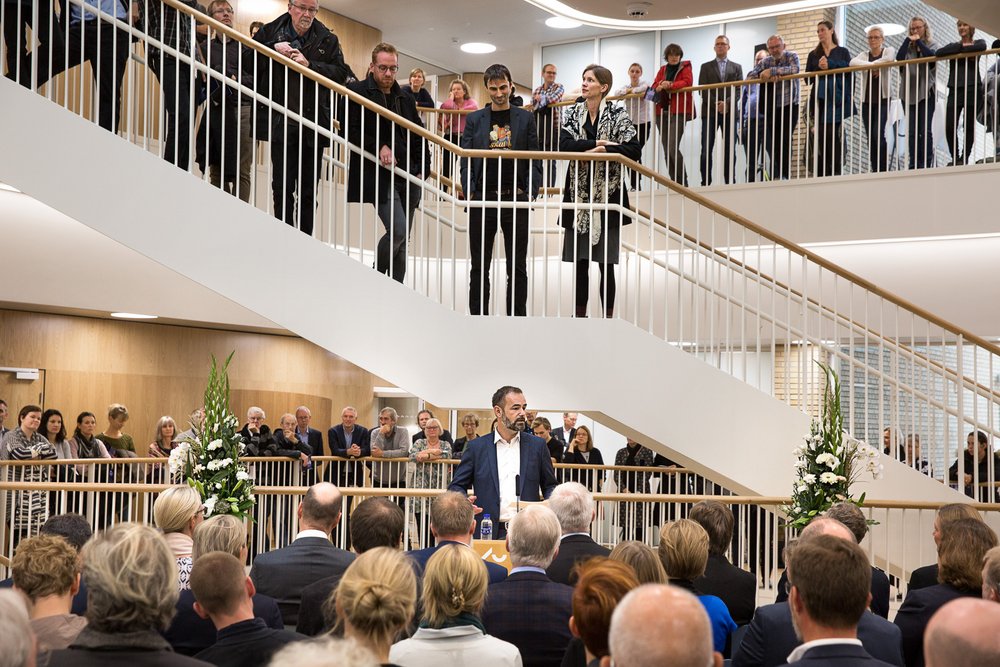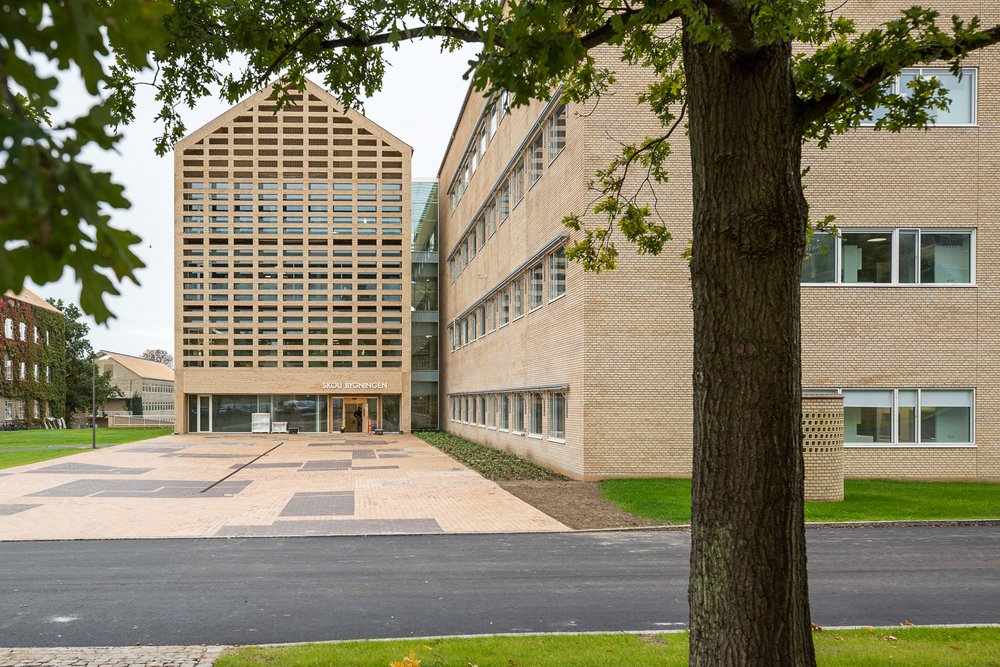- Education
-
Research
Current research
Talent
-
Collaboration
Businesses
Government agencies and institutions
Alumni
-
About AU
Organisation
Job at AU
Around three hundred guests, all with some kind of varying affiliation to the newly inaugurated Skou Building in the University Park, listened to speeches and were given a tour of the state-of-the-art research building. We’ll return to the crab claws...
2018.10.10 |
It was not a red ribbon, but rather a 3D printed DNA string, which was cut to celebrate the opening of the new yellow brick building, the Skou Building, in the University Park in Aarhus.
The inauguration took place on Monday 8 October, the very day when the man the building is named after – former Nobel Prize Laureate Jens Christian Skou – would have been one hundred years old.
The DNA string was cut by his widow Ellen-Margrethe Skou.

To great applause, Ellen-Margrethe Skou, Jens Christian Skou's widow, cut the “ribbon" to the new building. Photo: Lars Kruse, Aarhus University.
"Jens Christian never missed an opportunity to praise his working conditions and tell everyone how excellent they were, whether he was at home in Denmark or abroad. And once in a while I’d think: ‘Isn’t he exaggerating a little?’. But he couldn’t exaggerate what we have here. I hope others amongst us will do the same and praise the working conditions that Aarhus University provides for its researchers," she said in front of around three hundred guests sat on chairs and stood on the stairs and on the floor above the open atrium.
Architecturally impressive building
Jens Christian Skou's widow was not the only one of the day’s speakers to praise the building and the opportunities it creates for biomedical research.
"A stunningly beautiful new building in what is in my view the most beautiful campus in the world," was the description by the mayor of Aarhus Jacob Bundsgaard (Social Democrats).

Jacob Bundsgaard (Social Democrats), Mayor of Aarhus, looked forward to great opportunities and discoveries in the new biomedical research building. Photo: Lars Kruse, Aarhus University
"The building houses a level of ambition to make new, great discoveries," said the mayor, and also noted how the research environment helps to create jobs and positive "business adventures" resulting in large grants.
Lars Bo Nielsen, Dean of the Faculty of Health, used his speech to give an insight into how high-tech and modern the building's approx. 15,000 square metres are. But also to explain that, fortunately, it is not the pipes, wires, ventilation, robots and other automation which stand out.

The Skou Building was praised for matching the current yellow brick style but, at the same time, adding something new. Photo: Lars Kruse, Aarhus University.
"I'm not an architect, but I think many of you will agree with me that we’re inaugurating a building that is very impressive architecturally," said Lars Bo Nielsen.
He emphasised that the building is intended to create world-class research and attract and retain the brightest minds in the world.
"I believe that the Skou Building will be crucially important for the development of biomedical research in Denmark," said the dean.
The university’s rector, Brian Bech Nielsen, commented:
"If you were to have a building that reflected the importance of Jens Christian Skou for Aarhus University, it’d probably need a lot more floors."
The sky-high ambitions were a recurring theme among the speeches. One of those who shared high hopes for future research in the Skou Building was Anna Wedell, professor of physics at the Karolinska Institute and chair of the Nobel Prize Committee for Physics/Medicine.
"I hope we’ll come to see more Nobel Prizes from here," she said.
A dream which Jacob Bundsgaard said he shares.
"Who knows, maybe a seed has been planted today that will become the next Nobel Prize winner from Aarhus University," said the mayor in his speech.
Jens Christian Skou received the Nobel Prize in Chemistry in 1997 for his discovery of the sodium-potassium pump, a membrane pump that is necessary for the functioning of cells, among other things. The discovery was based on tests carried out on the nerve fibres from crabs – which is why the guests at the inauguration naturally enjoyed crab claws at the reception.
In addition to the reception, there was also a tour of the ultramodern laboratory animal facilities for mice and rats.

The tour for guests and journalists included the ultramodern laboratory animal facilities for as many as 30,000 mice and rats. Photo: Lars Kruse, Aarhus University.
Praise for the main man
Even though the man in question was not present, he still figured a lot in the speeches and the consciousness of all those present. Physiologist Jens Christian Skou is the most recent Dane to receive the Nobel Prize.
"He was – and will continue to be – a lodestar for other researchers. He has shown the way, shown how much you can achieve in Aarhus, and that despite our small size in an international context, we can still have big ambitions here in Aarhus," said Jacob Bundsgaard.
The university rector, Brian Bech Nielsen, also praised Jens Christian Skou's qualities as a researcher.
"He had all the qualities that characterise a genuine international elite researcher. He had a highly trained sense of wonder and he was exceptionally determined when pursuing this wonderment. He was concerned that his knowledge should benefit the students and society. And not least, Jens Christian was very persistent in his insistence on freedom as the very essence of good research," he said at Monday's inauguration.